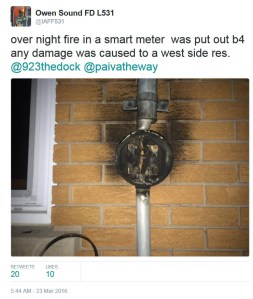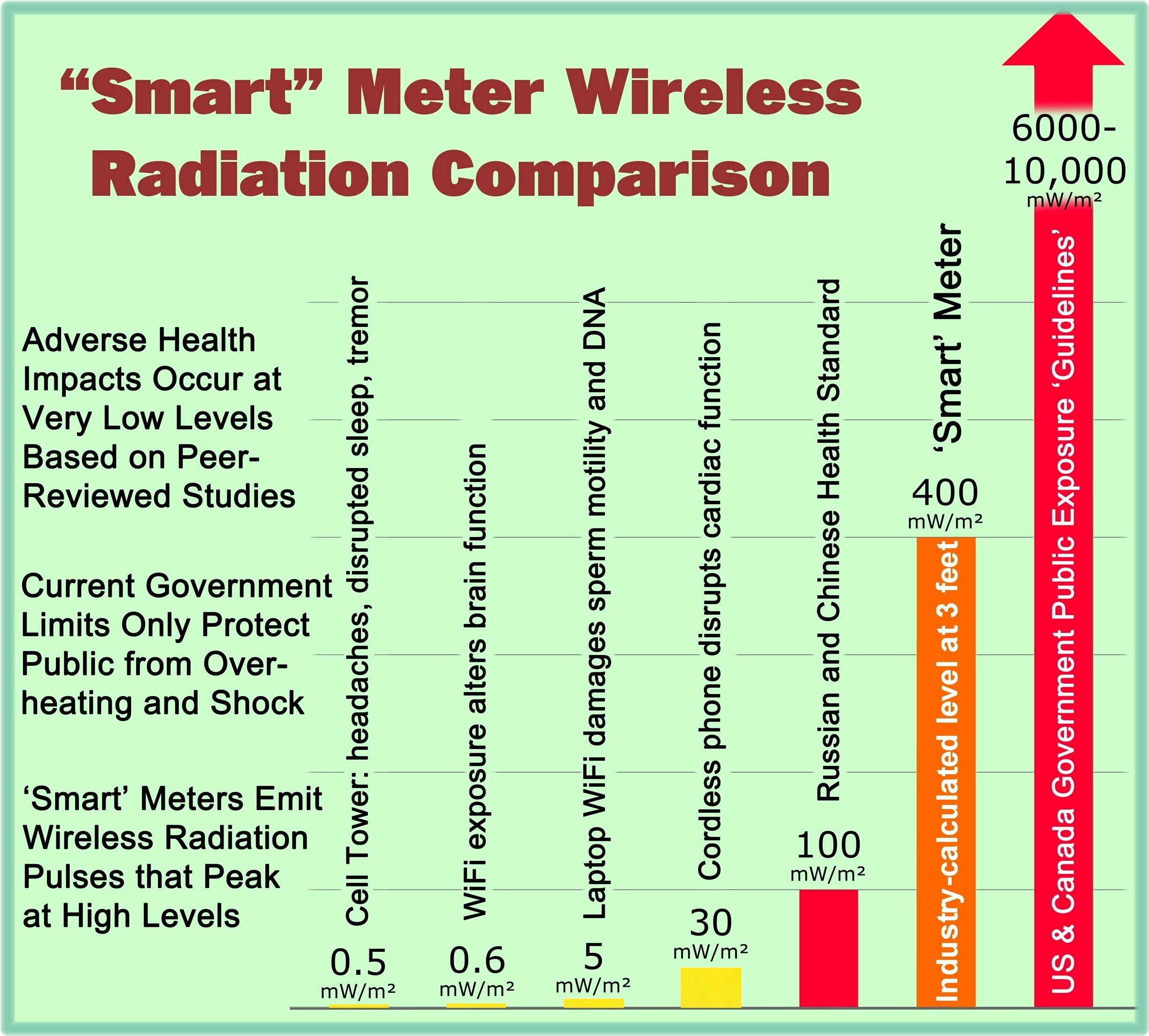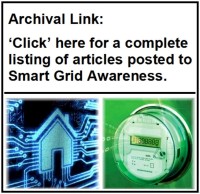 by K.T. Weaver, SkyVision Solutions
by K.T. Weaver, SkyVision Solutions
A utility industry document written in 2006 has been discovered that reviewed costs and benefits related to solid-state (digital) utility meters used for residential customers [1]. In that document, a senior vice-president for National Grid was quoted as follows:
“We lost several nights sleep worrying about catastrophic failures, but it was worth the risk.” [emphasis added]
In November 2015, I wrote a revealing article that catastrophic failures were expected with ‘smart’ meters [2]. In fact, I carefully worded the introductory sentence to that article stating, “Smart Meters are expected to occasionally fail catastrophically while analog meters do not have that failure mode.”
I recall choosing the word “occasionally” after considerable thought and was not aware of anyone having previously used that descriptive term as applied to digital utility meters. The term was the best one I could objectively choose given the intermittent yet persistent reports of digital utility meters burning/exploding in areas across the United States, Canada, and Australia where smart meters have been deployed.
To my surprise, the 2006 document uses the same term “occasionally” where it was written:
“The three utilities were quite frank that solid-state meters do fail occasionally while electromechanical meters rarely fail completely.” [emphasis added]
Thus, the language used in the 2006 industry document was almost identical to the language used in my November article, explaining that “electromechanical meters rarely fail completely.”
For review purposes and as covered in previous articles, I should be clear as to the standard definition for power meter catastrophic failures:
Catastrophic ‘Smart’ Meter Failure Definition: a meter which has burnt, melted, blackened, caught fire, arced, sparked, or exploded.
What one must understand is that although smart meter catastrophic meter failures may only occur “occasionally,” these occasional failures are difficult to justify from a cost/benefit basis perspective when the result can be injury, death, and destruction.
So why have utilities concluded that catastrophic meter failures are “worth the risk”? Based upon the context of how the 2006 industry article was written, it is clear that they are putting utility profits above that of public safety. The 2006 industry document details the following types of benefits associated with solid-state meters:
Higher accuracy, where “solid-state meters [are able] to measure load at very low levels compensates for the cost of the expected failure rate of solid-state meters. Residential customer loads are estimated to be less than 24 watts approximately five percent of the time. The solid-state meters are able to measure loads as low as five watts while electromechanical meters typically do not register energy usage unless it is over 24 watts. Thus, solid-state meters measure light loads that electromechanical meters can’t see, and more accurately measures loads that both types of meters register.”
Fewer calibrations, where calibration requirements are different between electromechanical and solid-state meters. “Electromechanical meters require a two point calibration: at full load and at light load, and should be recalibrated every five to eight years according to Mundorff. In contrast, solid-state meters only require a one-time one-point calibration. This leads to significant savings for the utilities since it costs $9 to ship, test, and repair the electromechanical meters.”
In summary, according to Tony Pini, senior vice president for National Grid (now retired):
“Solid-state meters are the gift that keeps on giving.”
So what are some examples of the results that can occur from smart meter fires in order for utility companies to experience the “gift that keeps on giving”? Here are two possible scenarios provided for illustration purposes.
Examples of Smart Meter Fires/Failures
March 2016 Smart Meter Fire in Owen Sound, Ontario
 On March 23rd, a smart meter fire occurred in Owen Sound, Ontario. According to news reports, there was minimal damage done to a home with a brick exterior and that “electrical issues could have caused the fire inside the meter.” However, “if the house had siding in the area of the meter — it would have caught the house on fire.” [3] [4]
On March 23rd, a smart meter fire occurred in Owen Sound, Ontario. According to news reports, there was minimal damage done to a home with a brick exterior and that “electrical issues could have caused the fire inside the meter.” However, “if the house had siding in the area of the meter — it would have caught the house on fire.” [3] [4]
So if a smart meter fire occurs and you happen to have a brick exterior for your home, you may be lucky and escape serious damage or injury.
February 2014 Apartment Building Fire in Bensalem, Pennsylvania
One of the best documented smart meter fires is for Bensalem, Pennsylvania, in February 2014. Based upon a report in the Bucks County Courier Times, Battalion Chief Robert Sponheimer indicated that the fire was caused by a “meter malfunction.” It was later confirmed that the fire was definitely started by a Landis smart meter [5].
The smart meter fire in Bensalem displaced thirty (30) residents at the Thunder Hollow apartments. Sixteen (16) apartments were affected. One firefighter was injured. In this instance the fire started in a smart meter located in a wooden shed attached to an apartment building. Residents reported hearing a loud bang, then losing power. Within minutes they saw smoke pouring out of the shed. The fire then spread to the building and its roof.
So if a catastrophic meter failure occurs when combustible materials are present, such as inside a wooden shed, devastation will likely occur.
Below is a 2-minute video summarizing the havoc caused by the smart meter fire at an apartment building in Pennsylvania in 2014.
The above video is presented in the public’s interest for non-commercial purposes. This video may contain material used pursuant to the Fair Use Doctrine under 17 U.S.C. 107.
Summary and Conclusion
I have written several comprehensive articles demonstrating that smart meters increase the risk for fires [5 through 11]. Evidence has also been revealed at this website on how smart meters suffer from a catastrophic failure mode not present for traditional electromechanical meters [2]. These catastrophic failures may only occur “occasionally,” but we have seen that these failures can result in varying levels of injury and devastation depending on the proximity of combustible materials near the meters. Utilities also make attempts to remove burned smart meter evidence from fire scenes hindering the efforts of fire investigators [12].
Now we learn that the electric utility industry was aware of catastrophic failures for solid-state meters as early as 2006 and that such failures were considered as “worth the risk.” I disagree.
References for this Article
[1] “Solid-State Meters at Three Utilities,” by Patti Harper-Slaboszewicz, UtiliPoint International, March 23, 2006, archived at: http://web.archive.org/web/20160419164411/https://www.itron.com/na/PublishedContent/Solid-State%20Meters%20at%20Three%20Utilities.pdf
[2] “Catastrophic Failures Expected with Smart Meters,” SkyVision Solutions Blog Article, November 2015, at https://smartgridawareness.org/2015/11/03/catastrophic-failures-expected-with-smart-meters/
[3] “Smart Meter Fire in Owen Sound,” Bayshore Broadcasting, March 23, 2016, at http://www.bayshorebroadcasting.ca/news_item.php?NewsID=83213
[4] Owen Sound Fire Department Tweet regarding Smart Meter Fire, March 23, 2016, at https://twitter.com/IAFF531/status/712621015017398272/photo/1
[5] “Smart Meter Malfunction Causes Pennsylvania Apartment Building Fire,” SkyVision Solutions Blog Article, February 2014, at https://smartgridawareness.org/2014/02/14/meter-blamed-for-pennsylvania-fire/
[6] “Smart Meters Increase the Risk of Fires!,” SkyVision Solutions Blog Article, August 2014, at https://smartgridawareness.org/2014/08/03/smart-meters-increase-the-risk-of-fires/
[7] “Smart Meter Fires Spread to Nevada: ‘Be Very Aware, Very Vigilant’ Says Fire Chief,” SkyVision Solutions Blog Article, September 2014, at https://smartgridawareness.org/2014/09/14/smart-meter-fires-spread-to-nevada/
[8] “Analog Meters Withstand ‘Hot Sockets’ Better Than Smart Meters,” SlyVision Solutions Blog Article, October 2014, at https://smartgridawareness.org/2014/10/16/analog-meters-withstand-hot-sockets-better-than-smart-meters/
[9] “Increased Risk of Smart Meter Fires Remains despite Receiving ‘Passing Grade’ for Nevada Test Samples,” SkyVision Solutions Blog Article, May 2015, at https://smartgridawareness.org/2015/05/06/increased-risk-of-smart-meter-fires-remains/
[10] “Utility Industry Aware of Safety and Accuracy Issues with Digital Meters for Years,” SkyVision Solutions Blog Article, June 2015, at https://smartgridawareness.org/2015/06/29/utility-industry-aware-of-issues-with-digital-meters-for-years/
[11] “NLRB Case Files and Judge’s Decision Confirm Smart Meter Fires, SkyVision Solutions Blog Article,” June 2015, at https://smartgridawareness.org/2015/06/30/nlrb-documents-smart-meter-fires/
[12] “Utilities Remove Burned Smart Meter Evidence from Fire Scenes,” SkyVision Solutions Blog Article, July 2015, at https://smartgridawareness.org/2015/07/28/utilities-remove-burned-smart-meter-evidence-from-fire-scenes/






Re: Reference #3. The fire department reported that the fire was due to a wiring fault inside the meter base. It was not due to the smart meter.
The news story at [3] and the Fire Department Tweet now added as [4] indicate the fire was “inside the meter” and “in a smart meter.” I was previously unaware of the audio for the news story as my browser privacy settings would not display the embedded audio play feature. In this case, it seems the person on the audio was speculating as to a possible cause of the fire using the language that it “COULD have been a loose connection inside the meter box.”
I have adjusted the language in the article slightly so as not to overstate the point of origin for the Owen Sound smart meter fire. However, I see little doubt that the smart meter did fail, and one must not fall prey to the utility industry narrative that all smart meter fires result from customer meter base problems that relieve the utility company from liability. As I have stated in other articles, the real issue is whether the failure/fire would have occurred if an analog meter had been present. Some meter failures have been attributed to, for example, the fact that the blades on smart meters were too thin in comparison to analog meter blades [Reference 11]. In addition, it has been found that analog meters withstand hot socket conditions better than smart meters [Reference 8].